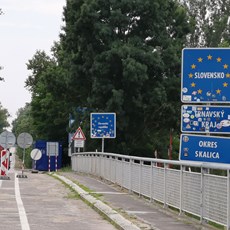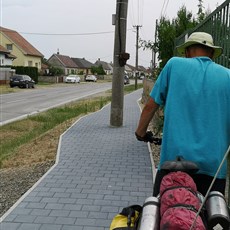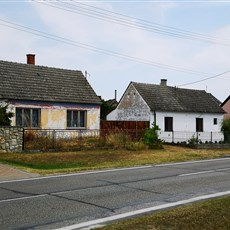Exchange rate: Rand 1 (R1) = Euro 0,048 (€0,048)
24-25 July 2023, Malė Levare, 58km
Autokemp Rudava €20 [R412]
"This is getting a little tedious." As Charl seldom complains, these were strong words uttered around 15km into Slovakia.
Before leaving Lednice, we strolled through a small segment of the Lednice castle gardens, breakfasted on the pavement on open sandwiches from the Coop (co-op) Jednota, and bought a selection of stamps for Charl's collection.
We were directed by Google Maps onto pleasant cycle paths and tracks that avoided much of sizeable Břeclav. Then pottered southeast on route 425 to our last Czech town, Lanžhot, where Charl imbibed his last Czech beer and I my last zmrzlina, strawberry sorbet.
While doing so on a terrace opposite the fire station, a deafening fire alarm sounded. Two women from the restaurant ran out to move their cars parked outside the station, a couple of men pulled up shortly thereafter, zipped into the open parking spots, dashed into the station to change, and soon were off in the fire engine to put out a fire somewhere.
Not much later we crossed the Morava River and without fuss or fanfare were in Slovakia.
Oddly, almost immediately, we found ourselves cycling into a hot headwind in oppressive humid weather; the air itself felt heavy. So, although the terrain was relatively easy, we struggled to do the distance, around 47km total.
The first couple of small towns we cycled through were clearly poorer than those in the neighbouring Czech Republic, the road a little rough.
We are staying at Autokemp Rudava, a large park with less than optimal ablutions, though adequate. When we asked about a room, we were offered accommodation in the unused playroom for just €3 more than the cost of camping. So we have an enormous room filled with day beds and toys...

Border between Czech Republic and Slovakia

En route Rudava

En route Rudava